FINANCE 6: Financial Analysis of Comprehensive Income Statement
VerifiedAdded on 2022/08/17
|10
|1688
|11
Report
AI Summary
This report offers a comprehensive financial analysis, exploring the purpose of the comprehensive income statement, which summarizes a firm's net assets, including income and expenses. It uses Singtel as an example to illustrate profit calculation, emphasizing the deduction of expenses from revenue. The report differentiates between single and two-statement formats, highlighting the users of the information. It defines income and expenses, explains historical cost, and details the purpose of the financial position, which reveals a firm's assets, liabilities, and capital. The analysis covers the components of financial position, including assets, liabilities, and equity, along with the impact of changes in these components. It explains the accrual basis of accounting, its principles (time period, revenue recognition, expenses recognition, and historical costs), and provides an example to illustrate cost of goods sold calculation. The report references relevant sources for further understanding.

Financial Analysis
Paraphrase This Document
Need a fresh take? Get an instant paraphrase of this document with our AI Paraphraser
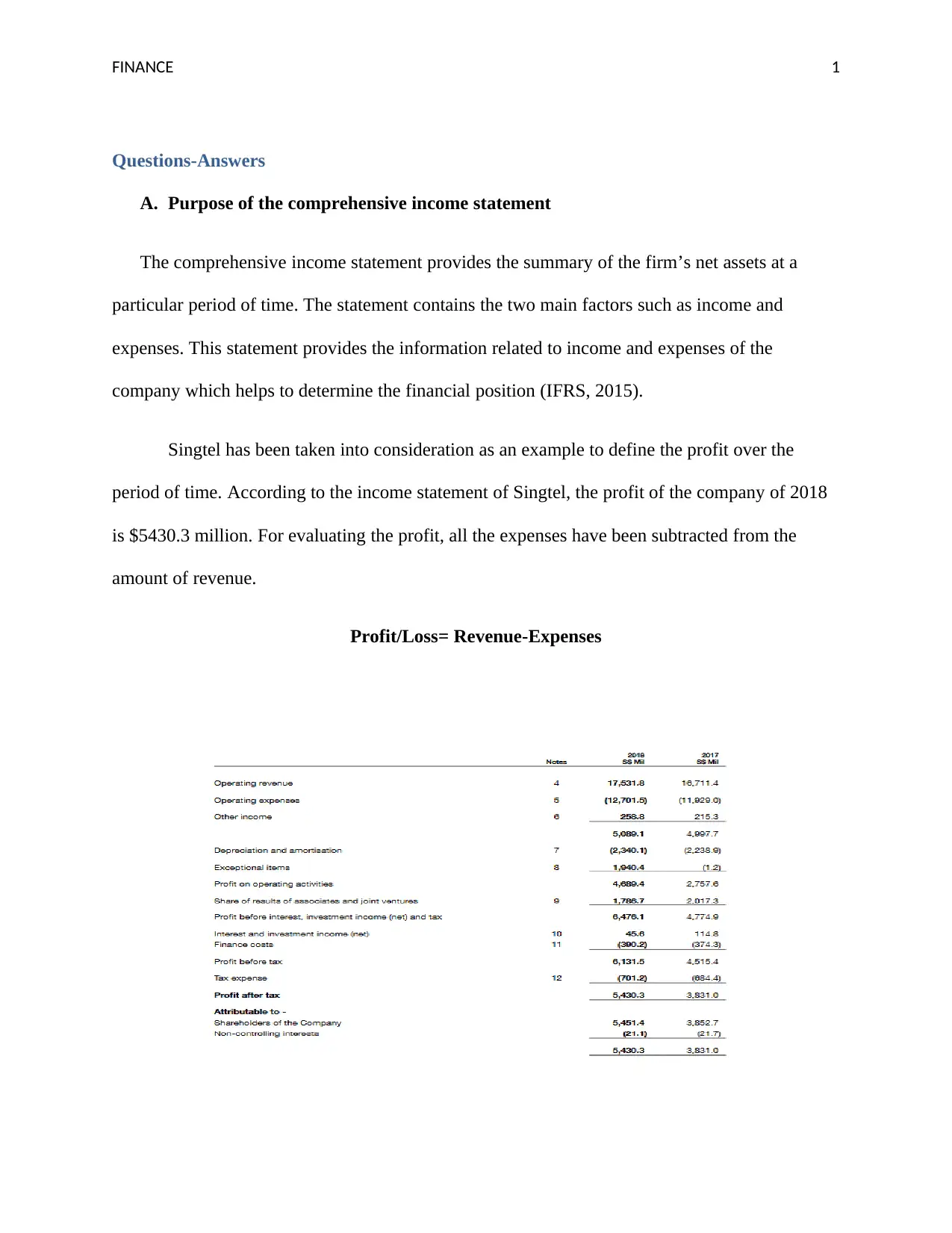
FINANCE 1
Questions-Answers
A. Purpose of the comprehensive income statement
The comprehensive income statement provides the summary of the firm’s net assets at a
particular period of time. The statement contains the two main factors such as income and
expenses. This statement provides the information related to income and expenses of the
company which helps to determine the financial position (IFRS, 2015).
Singtel has been taken into consideration as an example to define the profit over the
period of time. According to the income statement of Singtel, the profit of the company of 2018
is $5430.3 million. For evaluating the profit, all the expenses have been subtracted from the
amount of revenue.
Profit/Loss= Revenue-Expenses
Questions-Answers
A. Purpose of the comprehensive income statement
The comprehensive income statement provides the summary of the firm’s net assets at a
particular period of time. The statement contains the two main factors such as income and
expenses. This statement provides the information related to income and expenses of the
company which helps to determine the financial position (IFRS, 2015).
Singtel has been taken into consideration as an example to define the profit over the
period of time. According to the income statement of Singtel, the profit of the company of 2018
is $5430.3 million. For evaluating the profit, all the expenses have been subtracted from the
amount of revenue.
Profit/Loss= Revenue-Expenses
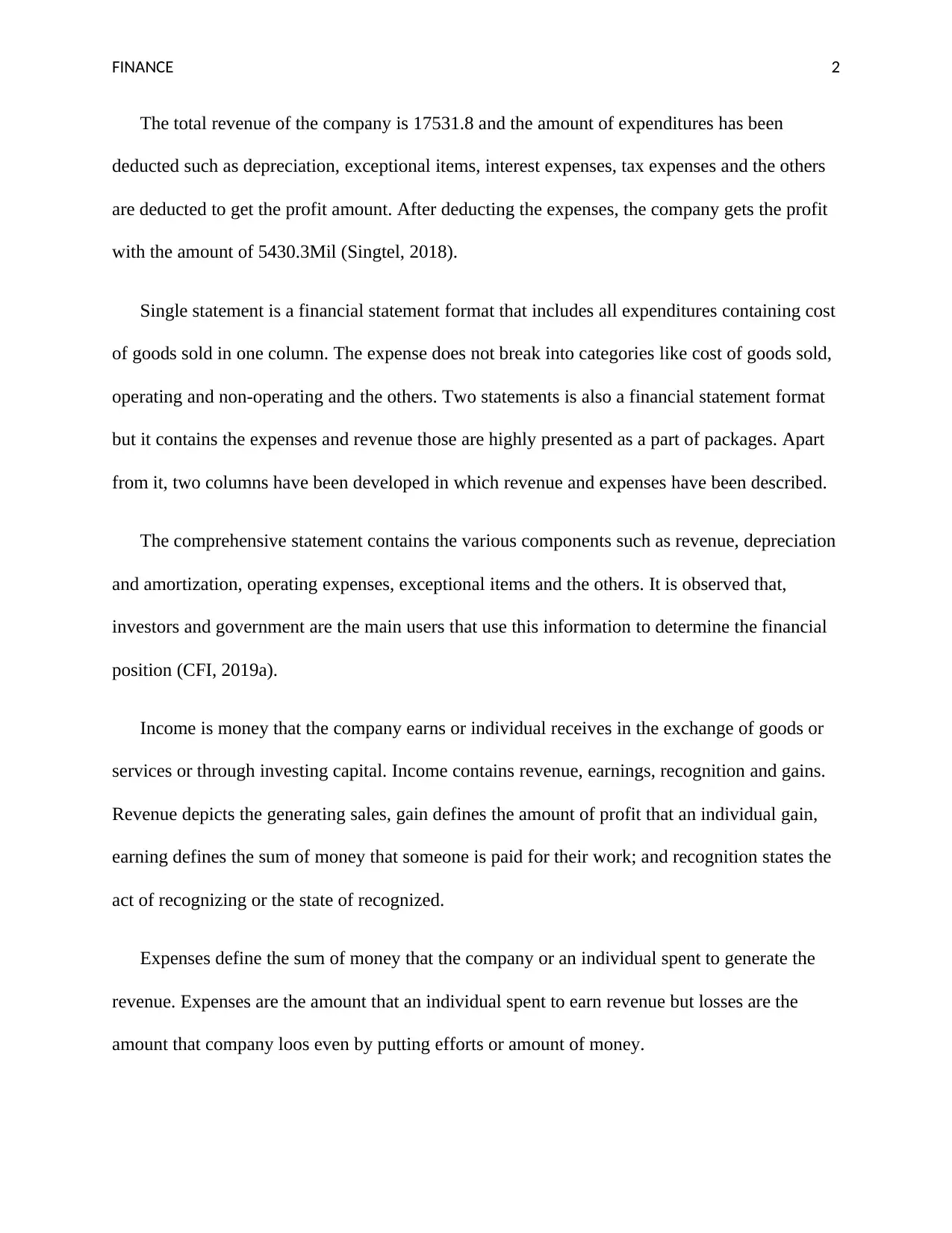
FINANCE 2
The total revenue of the company is 17531.8 and the amount of expenditures has been
deducted such as depreciation, exceptional items, interest expenses, tax expenses and the others
are deducted to get the profit amount. After deducting the expenses, the company gets the profit
with the amount of 5430.3Mil (Singtel, 2018).
Single statement is a financial statement format that includes all expenditures containing cost
of goods sold in one column. The expense does not break into categories like cost of goods sold,
operating and non-operating and the others. Two statements is also a financial statement format
but it contains the expenses and revenue those are highly presented as a part of packages. Apart
from it, two columns have been developed in which revenue and expenses have been described.
The comprehensive statement contains the various components such as revenue, depreciation
and amortization, operating expenses, exceptional items and the others. It is observed that,
investors and government are the main users that use this information to determine the financial
position (CFI, 2019a).
Income is money that the company earns or individual receives in the exchange of goods or
services or through investing capital. Income contains revenue, earnings, recognition and gains.
Revenue depicts the generating sales, gain defines the amount of profit that an individual gain,
earning defines the sum of money that someone is paid for their work; and recognition states the
act of recognizing or the state of recognized.
Expenses define the sum of money that the company or an individual spent to generate the
revenue. Expenses are the amount that an individual spent to earn revenue but losses are the
amount that company loos even by putting efforts or amount of money.
The total revenue of the company is 17531.8 and the amount of expenditures has been
deducted such as depreciation, exceptional items, interest expenses, tax expenses and the others
are deducted to get the profit amount. After deducting the expenses, the company gets the profit
with the amount of 5430.3Mil (Singtel, 2018).
Single statement is a financial statement format that includes all expenditures containing cost
of goods sold in one column. The expense does not break into categories like cost of goods sold,
operating and non-operating and the others. Two statements is also a financial statement format
but it contains the expenses and revenue those are highly presented as a part of packages. Apart
from it, two columns have been developed in which revenue and expenses have been described.
The comprehensive statement contains the various components such as revenue, depreciation
and amortization, operating expenses, exceptional items and the others. It is observed that,
investors and government are the main users that use this information to determine the financial
position (CFI, 2019a).
Income is money that the company earns or individual receives in the exchange of goods or
services or through investing capital. Income contains revenue, earnings, recognition and gains.
Revenue depicts the generating sales, gain defines the amount of profit that an individual gain,
earning defines the sum of money that someone is paid for their work; and recognition states the
act of recognizing or the state of recognized.
Expenses define the sum of money that the company or an individual spent to generate the
revenue. Expenses are the amount that an individual spent to earn revenue but losses are the
amount that company loos even by putting efforts or amount of money.
⊘ This is a preview!⊘
Do you want full access?
Subscribe today to unlock all pages.

Trusted by 1+ million students worldwide
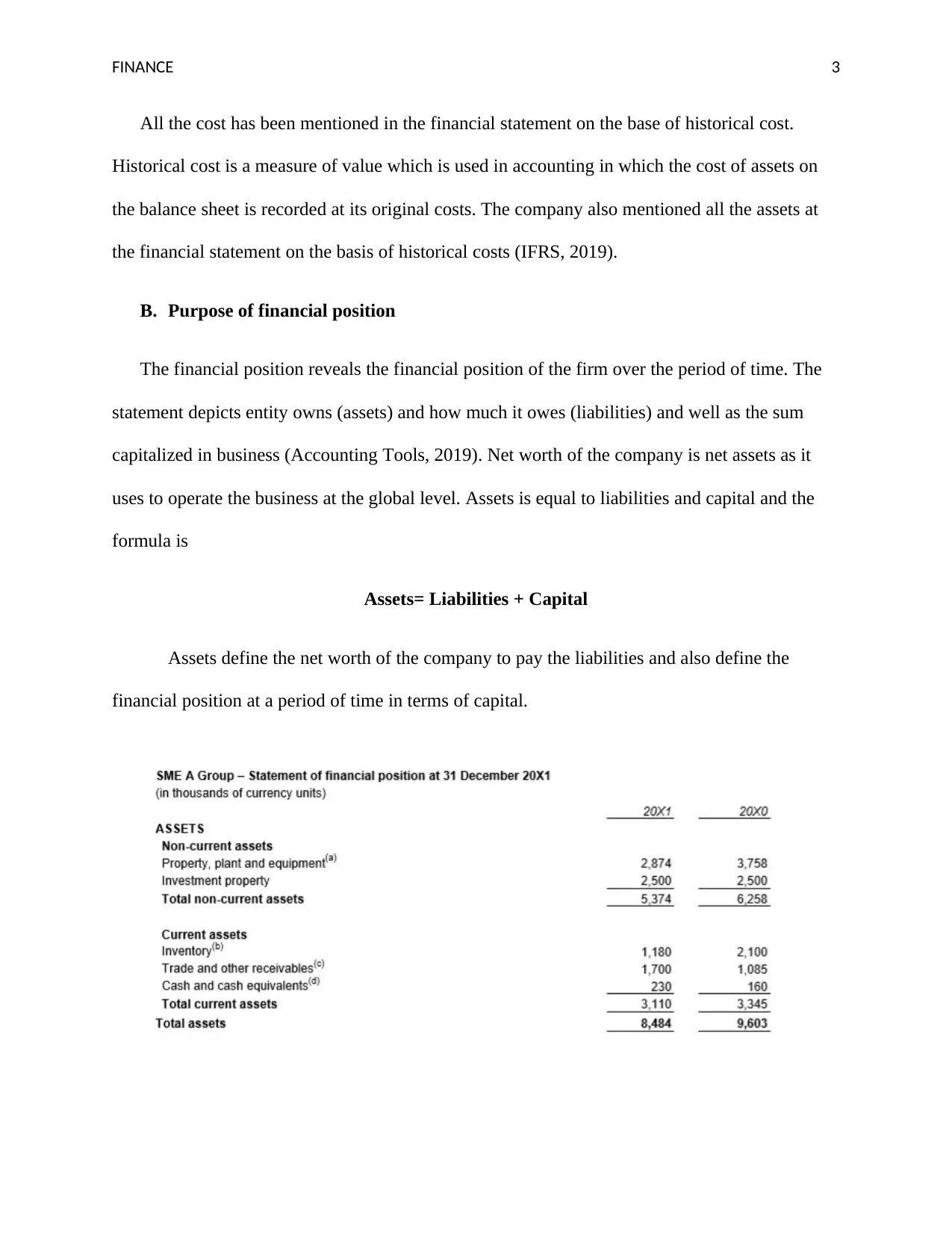
FINANCE 3
All the cost has been mentioned in the financial statement on the base of historical cost.
Historical cost is a measure of value which is used in accounting in which the cost of assets on
the balance sheet is recorded at its original costs. The company also mentioned all the assets at
the financial statement on the basis of historical costs (IFRS, 2019).
B. Purpose of financial position
The financial position reveals the financial position of the firm over the period of time. The
statement depicts entity owns (assets) and how much it owes (liabilities) and well as the sum
capitalized in business (Accounting Tools, 2019). Net worth of the company is net assets as it
uses to operate the business at the global level. Assets is equal to liabilities and capital and the
formula is
Assets= Liabilities + Capital
Assets define the net worth of the company to pay the liabilities and also define the
financial position at a period of time in terms of capital.
All the cost has been mentioned in the financial statement on the base of historical cost.
Historical cost is a measure of value which is used in accounting in which the cost of assets on
the balance sheet is recorded at its original costs. The company also mentioned all the assets at
the financial statement on the basis of historical costs (IFRS, 2019).
B. Purpose of financial position
The financial position reveals the financial position of the firm over the period of time. The
statement depicts entity owns (assets) and how much it owes (liabilities) and well as the sum
capitalized in business (Accounting Tools, 2019). Net worth of the company is net assets as it
uses to operate the business at the global level. Assets is equal to liabilities and capital and the
formula is
Assets= Liabilities + Capital
Assets define the net worth of the company to pay the liabilities and also define the
financial position at a period of time in terms of capital.
Paraphrase This Document
Need a fresh take? Get an instant paraphrase of this document with our AI Paraphraser
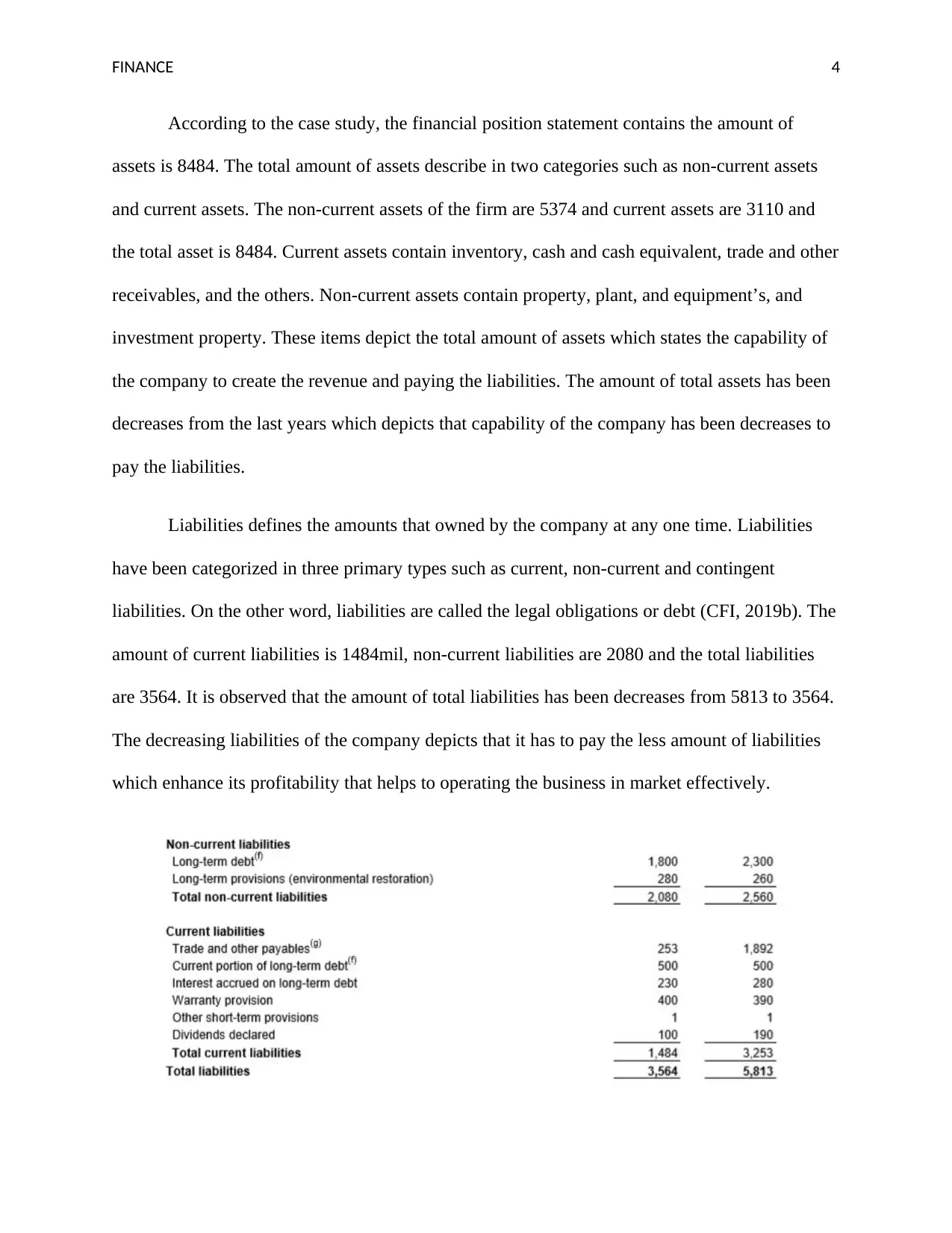
FINANCE 4
According to the case study, the financial position statement contains the amount of
assets is 8484. The total amount of assets describe in two categories such as non-current assets
and current assets. The non-current assets of the firm are 5374 and current assets are 3110 and
the total asset is 8484. Current assets contain inventory, cash and cash equivalent, trade and other
receivables, and the others. Non-current assets contain property, plant, and equipment’s, and
investment property. These items depict the total amount of assets which states the capability of
the company to create the revenue and paying the liabilities. The amount of total assets has been
decreases from the last years which depicts that capability of the company has been decreases to
pay the liabilities.
Liabilities defines the amounts that owned by the company at any one time. Liabilities
have been categorized in three primary types such as current, non-current and contingent
liabilities. On the other word, liabilities are called the legal obligations or debt (CFI, 2019b). The
amount of current liabilities is 1484mil, non-current liabilities are 2080 and the total liabilities
are 3564. It is observed that the amount of total liabilities has been decreases from 5813 to 3564.
The decreasing liabilities of the company depicts that it has to pay the less amount of liabilities
which enhance its profitability that helps to operating the business in market effectively.
According to the case study, the financial position statement contains the amount of
assets is 8484. The total amount of assets describe in two categories such as non-current assets
and current assets. The non-current assets of the firm are 5374 and current assets are 3110 and
the total asset is 8484. Current assets contain inventory, cash and cash equivalent, trade and other
receivables, and the others. Non-current assets contain property, plant, and equipment’s, and
investment property. These items depict the total amount of assets which states the capability of
the company to create the revenue and paying the liabilities. The amount of total assets has been
decreases from the last years which depicts that capability of the company has been decreases to
pay the liabilities.
Liabilities defines the amounts that owned by the company at any one time. Liabilities
have been categorized in three primary types such as current, non-current and contingent
liabilities. On the other word, liabilities are called the legal obligations or debt (CFI, 2019b). The
amount of current liabilities is 1484mil, non-current liabilities are 2080 and the total liabilities
are 3564. It is observed that the amount of total liabilities has been decreases from 5813 to 3564.
The decreasing liabilities of the company depicts that it has to pay the less amount of liabilities
which enhance its profitability that helps to operating the business in market effectively.
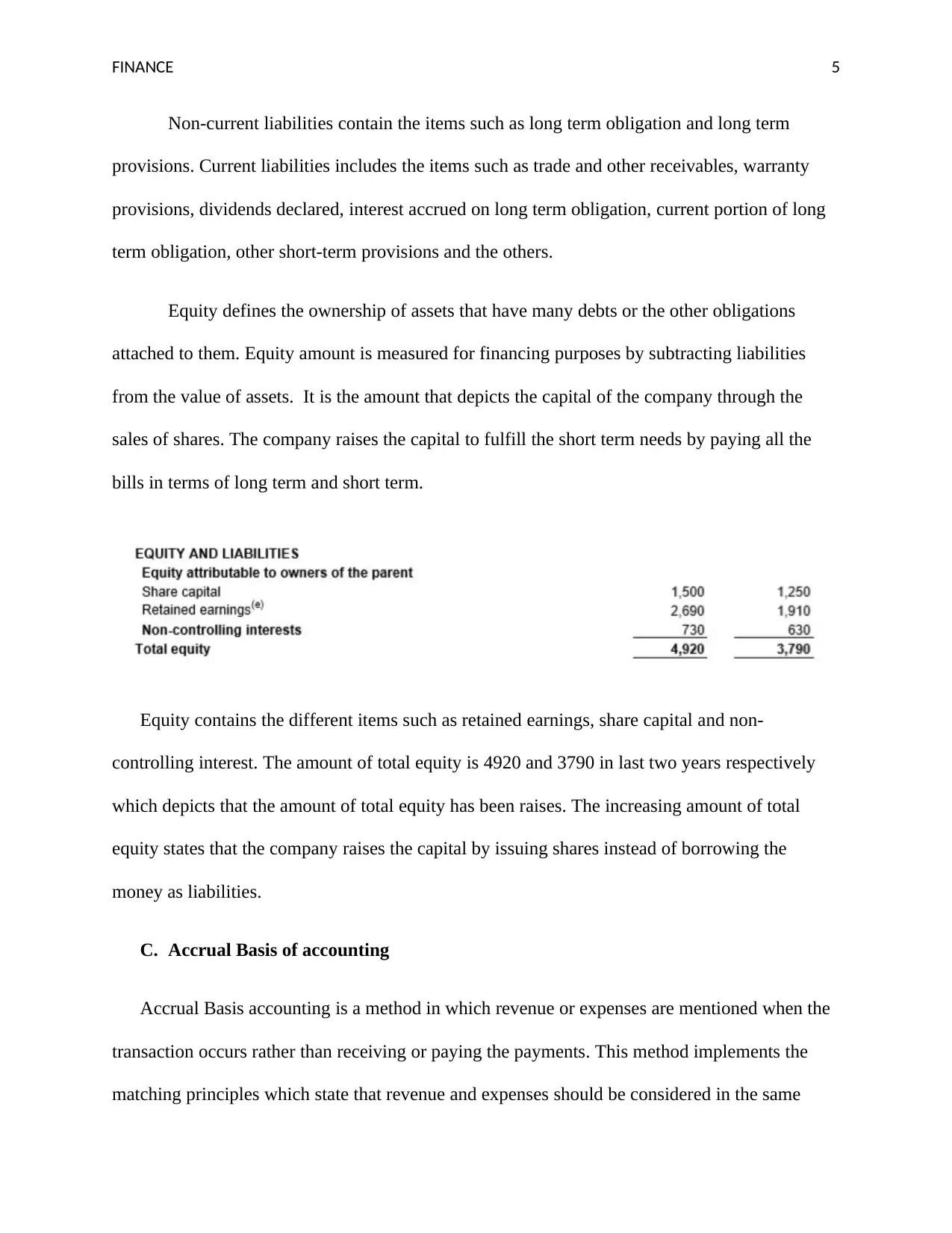
FINANCE 5
Non-current liabilities contain the items such as long term obligation and long term
provisions. Current liabilities includes the items such as trade and other receivables, warranty
provisions, dividends declared, interest accrued on long term obligation, current portion of long
term obligation, other short-term provisions and the others.
Equity defines the ownership of assets that have many debts or the other obligations
attached to them. Equity amount is measured for financing purposes by subtracting liabilities
from the value of assets. It is the amount that depicts the capital of the company through the
sales of shares. The company raises the capital to fulfill the short term needs by paying all the
bills in terms of long term and short term.
Equity contains the different items such as retained earnings, share capital and non-
controlling interest. The amount of total equity is 4920 and 3790 in last two years respectively
which depicts that the amount of total equity has been raises. The increasing amount of total
equity states that the company raises the capital by issuing shares instead of borrowing the
money as liabilities.
C. Accrual Basis of accounting
Accrual Basis accounting is a method in which revenue or expenses are mentioned when the
transaction occurs rather than receiving or paying the payments. This method implements the
matching principles which state that revenue and expenses should be considered in the same
Non-current liabilities contain the items such as long term obligation and long term
provisions. Current liabilities includes the items such as trade and other receivables, warranty
provisions, dividends declared, interest accrued on long term obligation, current portion of long
term obligation, other short-term provisions and the others.
Equity defines the ownership of assets that have many debts or the other obligations
attached to them. Equity amount is measured for financing purposes by subtracting liabilities
from the value of assets. It is the amount that depicts the capital of the company through the
sales of shares. The company raises the capital to fulfill the short term needs by paying all the
bills in terms of long term and short term.
Equity contains the different items such as retained earnings, share capital and non-
controlling interest. The amount of total equity is 4920 and 3790 in last two years respectively
which depicts that the amount of total equity has been raises. The increasing amount of total
equity states that the company raises the capital by issuing shares instead of borrowing the
money as liabilities.
C. Accrual Basis of accounting
Accrual Basis accounting is a method in which revenue or expenses are mentioned when the
transaction occurs rather than receiving or paying the payments. This method implements the
matching principles which state that revenue and expenses should be considered in the same
⊘ This is a preview!⊘
Do you want full access?
Subscribe today to unlock all pages.

Trusted by 1+ million students worldwide
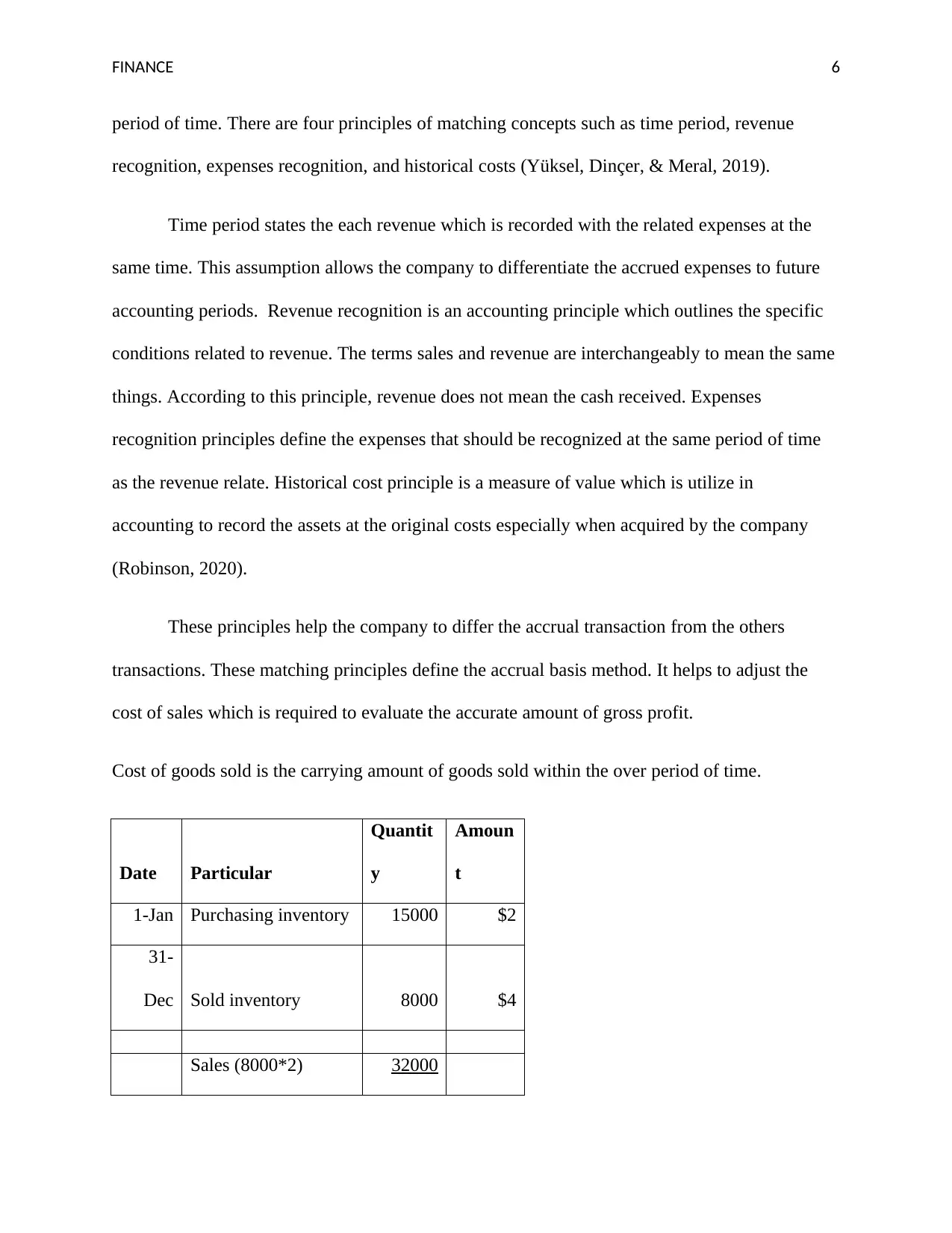
FINANCE 6
period of time. There are four principles of matching concepts such as time period, revenue
recognition, expenses recognition, and historical costs (Yüksel, Dinçer, & Meral, 2019).
Time period states the each revenue which is recorded with the related expenses at the
same time. This assumption allows the company to differentiate the accrued expenses to future
accounting periods. Revenue recognition is an accounting principle which outlines the specific
conditions related to revenue. The terms sales and revenue are interchangeably to mean the same
things. According to this principle, revenue does not mean the cash received. Expenses
recognition principles define the expenses that should be recognized at the same period of time
as the revenue relate. Historical cost principle is a measure of value which is utilize in
accounting to record the assets at the original costs especially when acquired by the company
(Robinson, 2020).
These principles help the company to differ the accrual transaction from the others
transactions. These matching principles define the accrual basis method. It helps to adjust the
cost of sales which is required to evaluate the accurate amount of gross profit.
Cost of goods sold is the carrying amount of goods sold within the over period of time.
Date Particular
Quantit
y
Amoun
t
1-Jan Purchasing inventory 15000 $2
31-
Dec Sold inventory 8000 $4
Sales (8000*2) 32000
period of time. There are four principles of matching concepts such as time period, revenue
recognition, expenses recognition, and historical costs (Yüksel, Dinçer, & Meral, 2019).
Time period states the each revenue which is recorded with the related expenses at the
same time. This assumption allows the company to differentiate the accrued expenses to future
accounting periods. Revenue recognition is an accounting principle which outlines the specific
conditions related to revenue. The terms sales and revenue are interchangeably to mean the same
things. According to this principle, revenue does not mean the cash received. Expenses
recognition principles define the expenses that should be recognized at the same period of time
as the revenue relate. Historical cost principle is a measure of value which is utilize in
accounting to record the assets at the original costs especially when acquired by the company
(Robinson, 2020).
These principles help the company to differ the accrual transaction from the others
transactions. These matching principles define the accrual basis method. It helps to adjust the
cost of sales which is required to evaluate the accurate amount of gross profit.
Cost of goods sold is the carrying amount of goods sold within the over period of time.
Date Particular
Quantit
y
Amoun
t
1-Jan Purchasing inventory 15000 $2
31-
Dec Sold inventory 8000 $4
Sales (8000*2) 32000
Paraphrase This Document
Need a fresh take? Get an instant paraphrase of this document with our AI Paraphraser
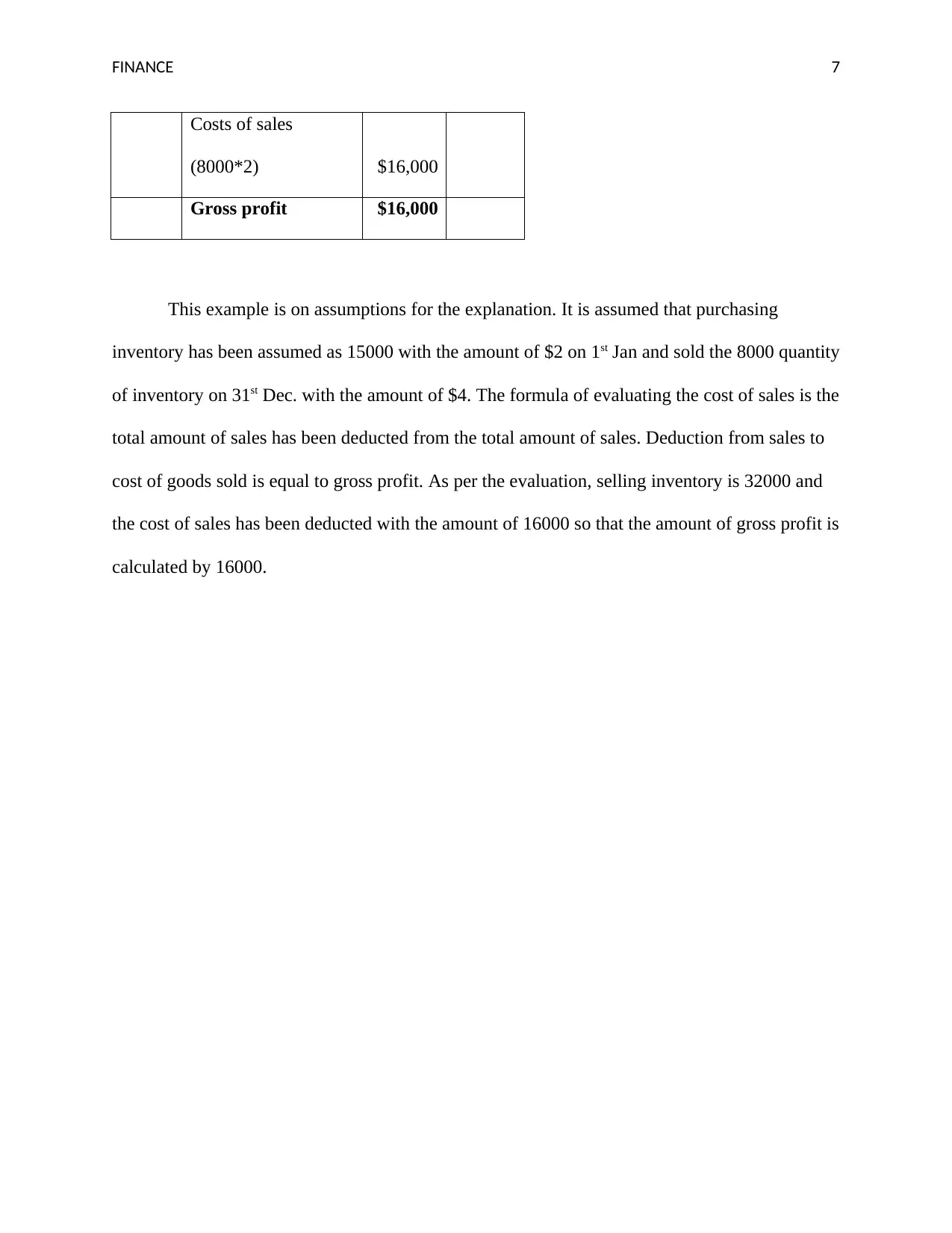
FINANCE 7
Costs of sales
(8000*2) $16,000
Gross profit $16,000
This example is on assumptions for the explanation. It is assumed that purchasing
inventory has been assumed as 15000 with the amount of $2 on 1st Jan and sold the 8000 quantity
of inventory on 31st Dec. with the amount of $4. The formula of evaluating the cost of sales is the
total amount of sales has been deducted from the total amount of sales. Deduction from sales to
cost of goods sold is equal to gross profit. As per the evaluation, selling inventory is 32000 and
the cost of sales has been deducted with the amount of 16000 so that the amount of gross profit is
calculated by 16000.
Costs of sales
(8000*2) $16,000
Gross profit $16,000
This example is on assumptions for the explanation. It is assumed that purchasing
inventory has been assumed as 15000 with the amount of $2 on 1st Jan and sold the 8000 quantity
of inventory on 31st Dec. with the amount of $4. The formula of evaluating the cost of sales is the
total amount of sales has been deducted from the total amount of sales. Deduction from sales to
cost of goods sold is equal to gross profit. As per the evaluation, selling inventory is 32000 and
the cost of sales has been deducted with the amount of 16000 so that the amount of gross profit is
calculated by 16000.
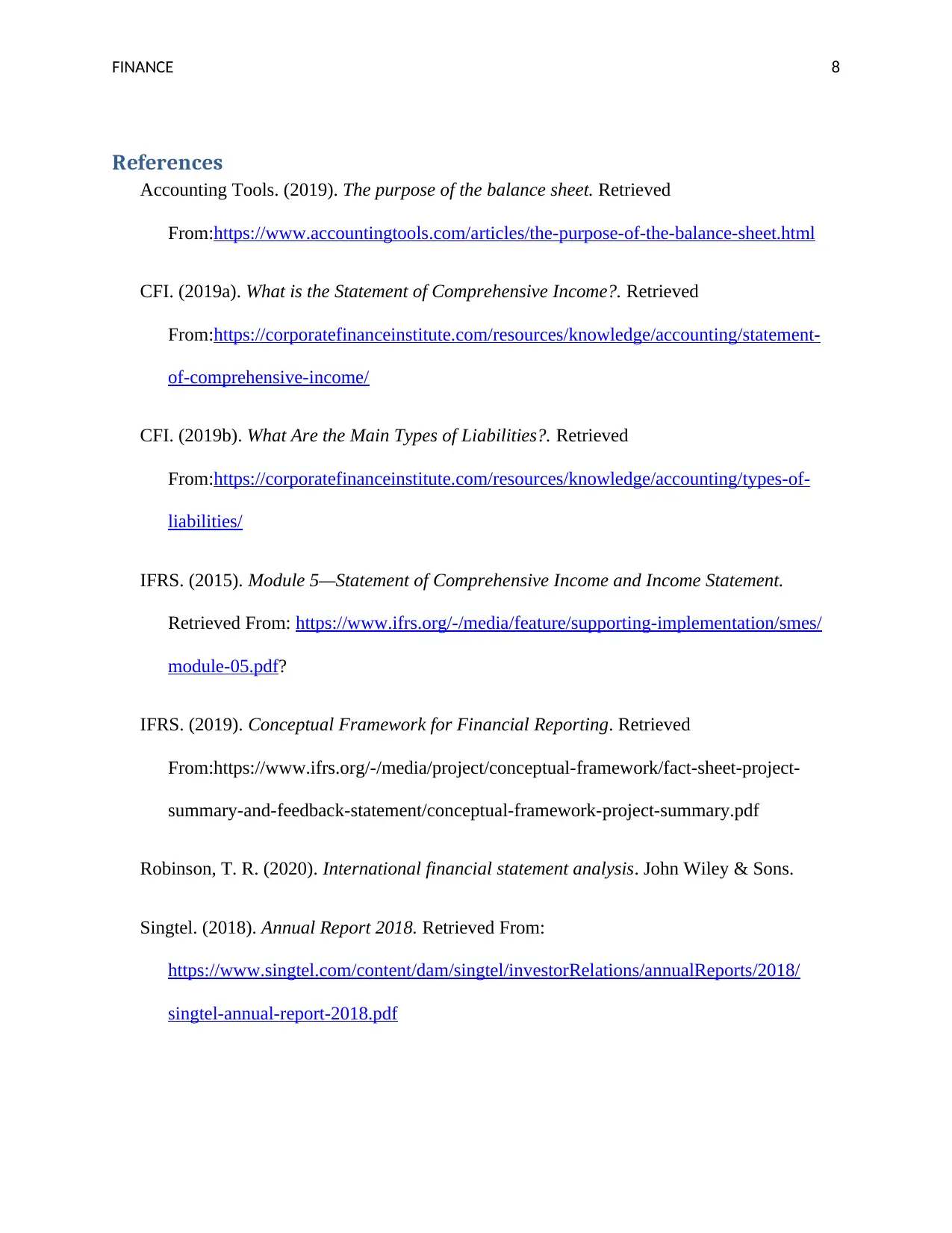
FINANCE 8
References
Accounting Tools. (2019). The purpose of the balance sheet. Retrieved
From:https://www.accountingtools.com/articles/the-purpose-of-the-balance-sheet.html
CFI. (2019a). What is the Statement of Comprehensive Income?. Retrieved
From:https://corporatefinanceinstitute.com/resources/knowledge/accounting/statement-
of-comprehensive-income/
CFI. (2019b). What Are the Main Types of Liabilities?. Retrieved
From:https://corporatefinanceinstitute.com/resources/knowledge/accounting/types-of-
liabilities/
IFRS. (2015). Module 5—Statement of Comprehensive Income and Income Statement.
Retrieved From: https://www.ifrs.org/-/media/feature/supporting-implementation/smes/
module-05.pdf?
IFRS. (2019). Conceptual Framework for Financial Reporting. Retrieved
From:https://www.ifrs.org/-/media/project/conceptual-framework/fact-sheet-project-
summary-and-feedback-statement/conceptual-framework-project-summary.pdf
Robinson, T. R. (2020). International financial statement analysis. John Wiley & Sons.
Singtel. (2018). Annual Report 2018. Retrieved From:
https://www.singtel.com/content/dam/singtel/investorRelations/annualReports/2018/
singtel-annual-report-2018.pdf
References
Accounting Tools. (2019). The purpose of the balance sheet. Retrieved
From:https://www.accountingtools.com/articles/the-purpose-of-the-balance-sheet.html
CFI. (2019a). What is the Statement of Comprehensive Income?. Retrieved
From:https://corporatefinanceinstitute.com/resources/knowledge/accounting/statement-
of-comprehensive-income/
CFI. (2019b). What Are the Main Types of Liabilities?. Retrieved
From:https://corporatefinanceinstitute.com/resources/knowledge/accounting/types-of-
liabilities/
IFRS. (2015). Module 5—Statement of Comprehensive Income and Income Statement.
Retrieved From: https://www.ifrs.org/-/media/feature/supporting-implementation/smes/
module-05.pdf?
IFRS. (2019). Conceptual Framework for Financial Reporting. Retrieved
From:https://www.ifrs.org/-/media/project/conceptual-framework/fact-sheet-project-
summary-and-feedback-statement/conceptual-framework-project-summary.pdf
Robinson, T. R. (2020). International financial statement analysis. John Wiley & Sons.
Singtel. (2018). Annual Report 2018. Retrieved From:
https://www.singtel.com/content/dam/singtel/investorRelations/annualReports/2018/
singtel-annual-report-2018.pdf
⊘ This is a preview!⊘
Do you want full access?
Subscribe today to unlock all pages.

Trusted by 1+ million students worldwide
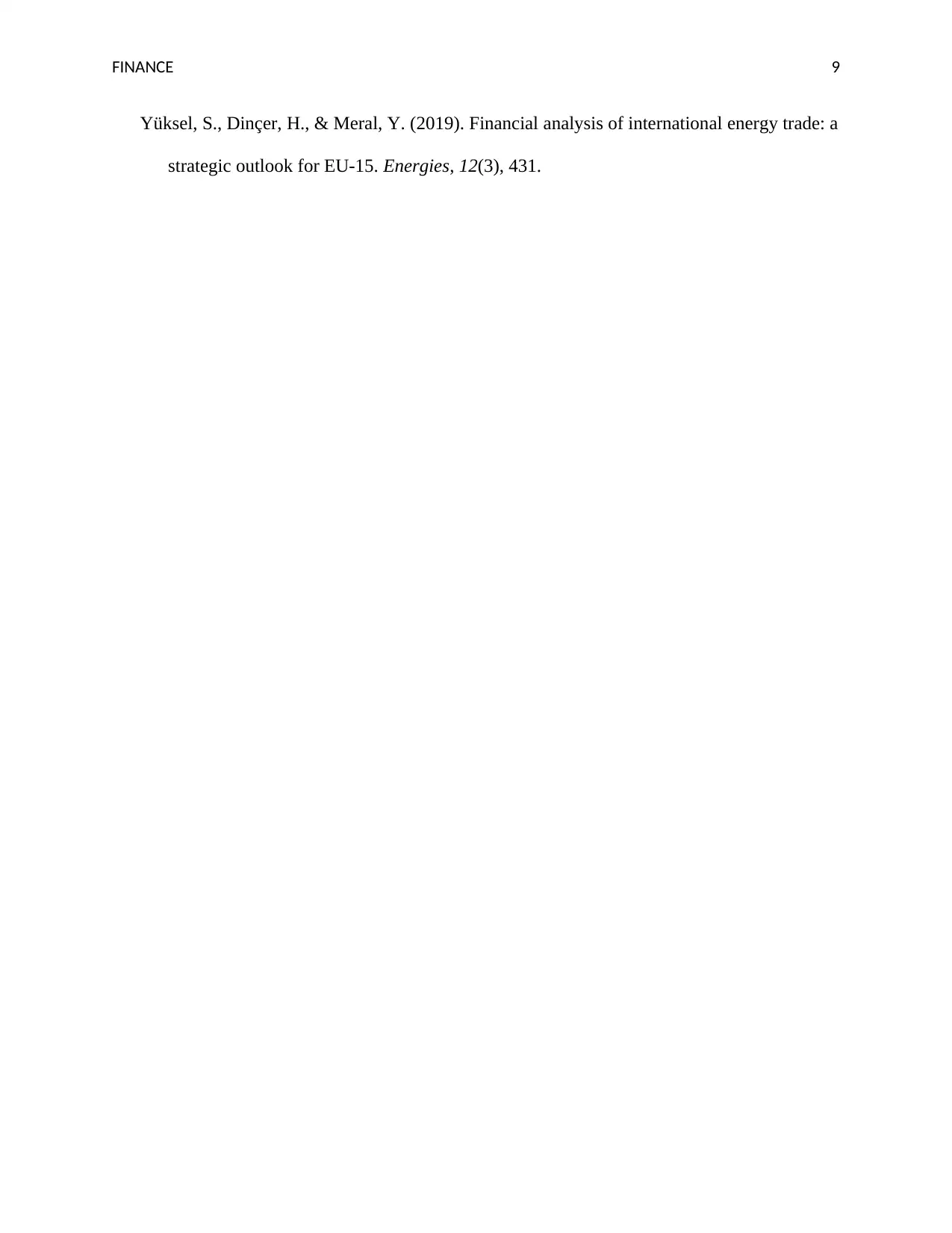
FINANCE 9
Yüksel, S., Dinçer, H., & Meral, Y. (2019). Financial analysis of international energy trade: a
strategic outlook for EU-15. Energies, 12(3), 431.
Yüksel, S., Dinçer, H., & Meral, Y. (2019). Financial analysis of international energy trade: a
strategic outlook for EU-15. Energies, 12(3), 431.
1 out of 10
Related Documents
Your All-in-One AI-Powered Toolkit for Academic Success.
+13062052269
info@desklib.com
Available 24*7 on WhatsApp / Email
![[object Object]](/_next/static/media/star-bottom.7253800d.svg)
Unlock your academic potential
Copyright © 2020–2025 A2Z Services. All Rights Reserved. Developed and managed by ZUCOL.




